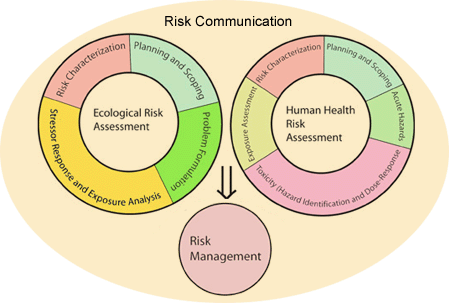Superfund Risk Assessment
This website is intended primarily to be a resource for EPA, State, other federal agency and contractor risk assessors and toxicologists. It provides guidance, tools and databases that might be useful in preparing human health and ecological risk assesments on the types of hazardous waste sites addressed by OSWER programs. To some extent, it may also be of interest to some citizens and risk managers who wish to understand the risk assessment process in greater detail. Superfund risk assessments determine how threatening a hazardous waste site is to human health and the environment. Risk Assessors seek to determine a safe level for each potentially dangerous contaminant present. For humans, this is a level at which ill health effects are unlikely and the probability of cancer is very small. For ecological receptors, determining the level of risk is more complicated and is a function of the receptors of concern, the nature of the adverse effects caused by the contaminants, and the desired condition of the ecological resources. There is Ecological Risk Assessment Guidance which should be followed when assessing risks at Superfund sites.
Each Superfund site is unique in terms of the contaminants present and their potential health effects. Therefore, EPA conducts risk assessments on a site-by- site basis. The risk assessment estimates the current and possible future risks, if no action were taken to clean up the site. Superfund's goal is to manage risks to acceptable levels, and risk managers incorporate risk assessment information with a variety of site factors to select the best cleanup strategies.
Choose a topic at the top of the page to view Superfund-related Risk Assessment information.
Superfund Risk Assessment Paradigm
This diagram represents the components of ecological and human health
risk assessments in the CERCLA (Superfund) and RCRA programs. Risk
Assessments may proceed in a straightforward, linear fashion, but
often repeat stages depending on sampling and analytical results
and on decisions made by risk assessors and risk managers. Hence,
the components of a risk assessment are shown in a circular fashion,
rather than strictly linear (click on the map for more information
on the various topics).

Although Ecological Risk Assessments in Superfund are often done in an eight-step process, those steps can be combined into the four categories in the "Ecological Risk Assessment" circle. For more information on the eight-step process please visit either of the following links:
- Ecological Risk Assessment in Superfund (an overview of the eight-step process)
- Ecological Risk Assessment Guidance for Superfund: Process for Designing and Conducting Ecological Risk Assessments - Interim Final
EPA's Ecological Risk Assessment Support Center (ERASC)
The ERASC provides technical information and addresses scientific questions of concern or interest on topics relevant to ecological risk assessment at hazardous waste sites for EPA's Office of Solid Waste and Emergency Response (OSWER) personnel and Regional Superfund/Resource Conservation and Recovery Act (RCRA) staff. Requests must be channeled to ERASC through the Ecological Risk Assessment Forum (ERAF). To assess emerging and complex scientific issues that require expert judgment, the ERASC relies on the expertise of scientists and engineers located throughout EPA Office of Research and Development (ORD) labs and centers. ERASC develops responses that reflect the "state of the science" for ecological risk assessment and also provides a communication point for the distribution of the responses to other interested parties.
For further information, contact Erasc.Ecology@epa.gov or call 513-569-7940 or visit ERASC's website at www.epa.gov/erasc
For additional information on the Human Health process in Superfund, see Risk Assessment Guidance for Superfund (RAGS) Part A
![[logo] US EPA](https://webarchive.library.unt.edu/eot2008/20090115173509im_/http://www.epa.gov/epafiles/images/logo_epaseal.gif)